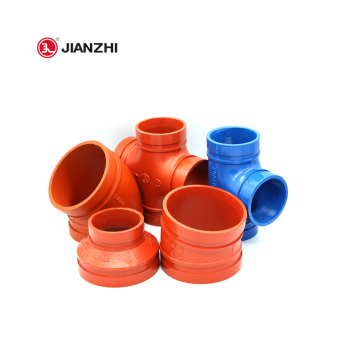Jul. 12, 2023
1.Pipes and valves
1) Buried pipes:
When the system working pressure is not greater than 1.20MPa, it is appropriate to use ductile iron pipe or steel wire mesh skeleton plastic composite pipe water supply pipeline; when the system working pressure is greater than 1.20MPa and less than 1.60MPa, it is appropriate to use steel wire mesh skeleton plastic composite pipe, thickened steel pipe and seamless steel pipe; when the system working pressure is greater than 1.60MPa, it is appropriate to use seamless steel pipe.
2) Overhead piping:
When the system working pressure is less than or equal to 1.20MPa, hot dipped galvanized steel pipe can be used; when the system working pressure is greater than 1.20MPa, hot dipped galvanized thickened steel pipe or hot dipped galvanized seamless steel pipe should be used; when the system working pressure is greater than 1.60MPa, hot dipped galvanized seamless steel pipe should be used.
3) Vales
①Concealed stem gate valves with opening and closing scales are preferred for buried pipelines, while corrosion-resistant open stem gate valves can be used when set in valve wells.
②The valves for indoor overhead pipes should be butterfly valves, open stem gate valves or concealed stem gate valves with opening and closing scales, etc.
③Outdoor overhead pipelines should use concealed stem gates with opening and closing scales or corrosion resistant open stem gates.
④Ductile iron valves should be used for buried pipelines, ductile iron or stainless steel valves for indoor overhead pipelines and ductile iron or stainless steel valves for outdoor overhead pipelines.
⑤Automatic venting valves should be provided at the highest points of the fire protection water supply system pipes.
⑥The water hammer elimination check valve should be used on the fire pump discharge pipe and the water hammer eliminator should be used when the water supply height of the fire pump exceeds 24m. When there is a bladder type pneumatic water tank on the fire pump discharge pipe, water hammer elimination facilities may not be provided.
2.Requirements for the installation of outdoor fire protection water supply networks
1) A ring pipe network should be used for outdoor fire-fighting water supply when two fire-fighting water supplies are used, but a branch pipe network can be used when one fire-fighting water supply is used.
2) There should be no less than two incoming water pipes to the ring network, and when one of them fails, the remaining incoming pipes should be able to meet the total water supply requirements for fire fighting.
3) The diameter of the pipe should be determined by calculation according to the flow rate, flow rate and pressure requirements, but should not be less than DN100.
4) The fire protection water pipeline should be divided into a number of independent sections using valves, and the number of outdoor fire hydrants in each section should not exceed 5.
3.Requirements for the installation of indoor fire protection water supply networks
1) 1) Indoor fire hydrant system pipe network should be arranged as a ring, when the design flow of outdoor fire hydrant is not more than 20L/s, and indoor fire hydrant does not exceed 10, except for special requirements, can be arranged as a branch.
2) When directly supplied by the outdoor production and life fire fighting system, the combined system should meet the design flow of outdoor fire fighting water supply and the requirements of the maximum hourly design flow of production and life, and should also meet the design flow and pressure requirements of the indoor fire fighting water supply system.
3) The diameter of the indoor fire hydrant riser shall be determined by calculation according to the minimum flow rate of the riser, but shall not be less than DN100.
4) Indoor fire hydrant ring water supply pipe maintenance shall comply with the following provisions:
①The indoor fire hydrant riser should ensure that no more than 1 riser is closed when the pipework is being serviced, and that when there are more than 4 risers, the 2 that are not adjacent can be closed.
②A valve shall be provided at the point where each vertical pipe meets the horizontal main of the water supply.
4.Design flow rates for fire protection water mains
The design flow rate of fire-fighting water supply pipes should not be greater than 2.5m/s, and the water supply flow rate of any fire-fighting pipe should not be greater than 7m/s.

This is the first part of our release and there is a second part to come, so please stay tuned.
Jianzhi Group also produces more different types of grooved pipe fittings. You can click the link below to enter the official YOUTUBE channel of Jianzhi Group for more product information. In addition, welcome to consult us directly.
https://www.youtube.com/watch?v=RO7-xIos2_E&t=189s
SAFER
PRODUCT INFO
ABOUT JIANZHI
TECH DATA
Contact Us
E-mail: sales1@jianzhi-fitting.com
Tel: +86 18698027872
Office In Tianjin:
Heping District, Tianjin, China.
Production Base 1:
Chifeng, Inner Mongolia, China.
Production Base 2:
Tangshan City, Hebei Province, China.
Production Base 3:
Schelei Street,Baicoi City,Prahova County,Romania
Service email: info.ro@jianzhi-fitting.com
Sales email: market.ro@jianzhi-fitting.com
Tel: +40(755)011 849
